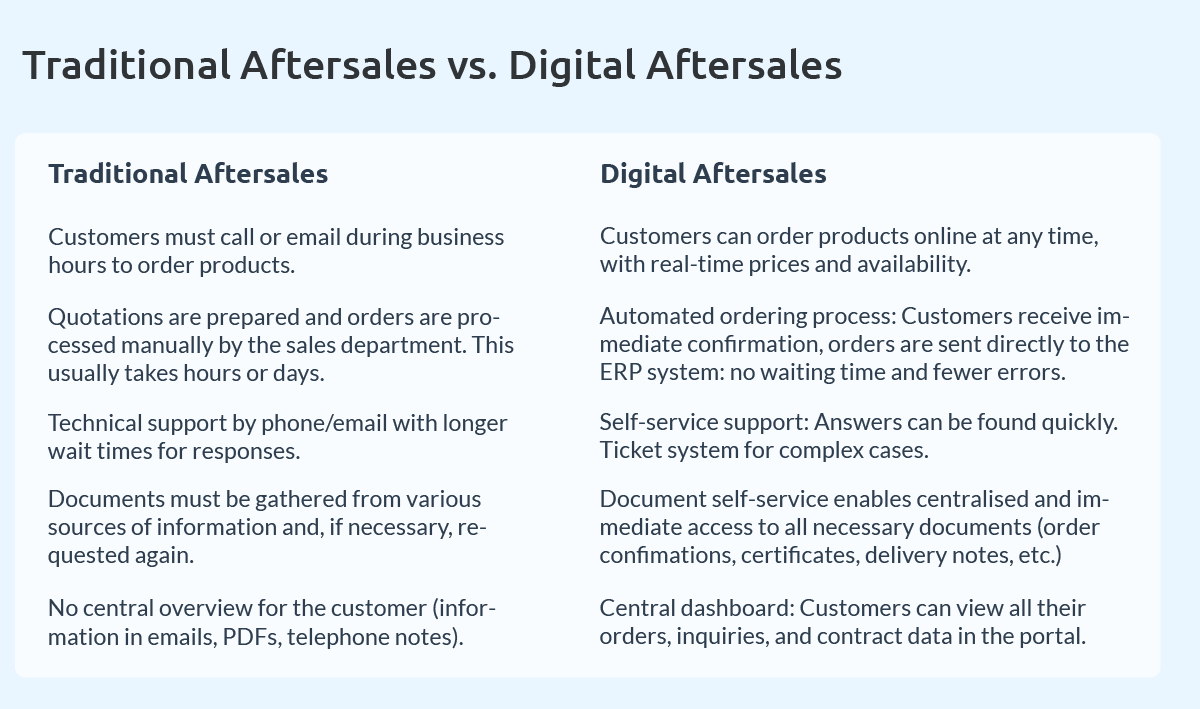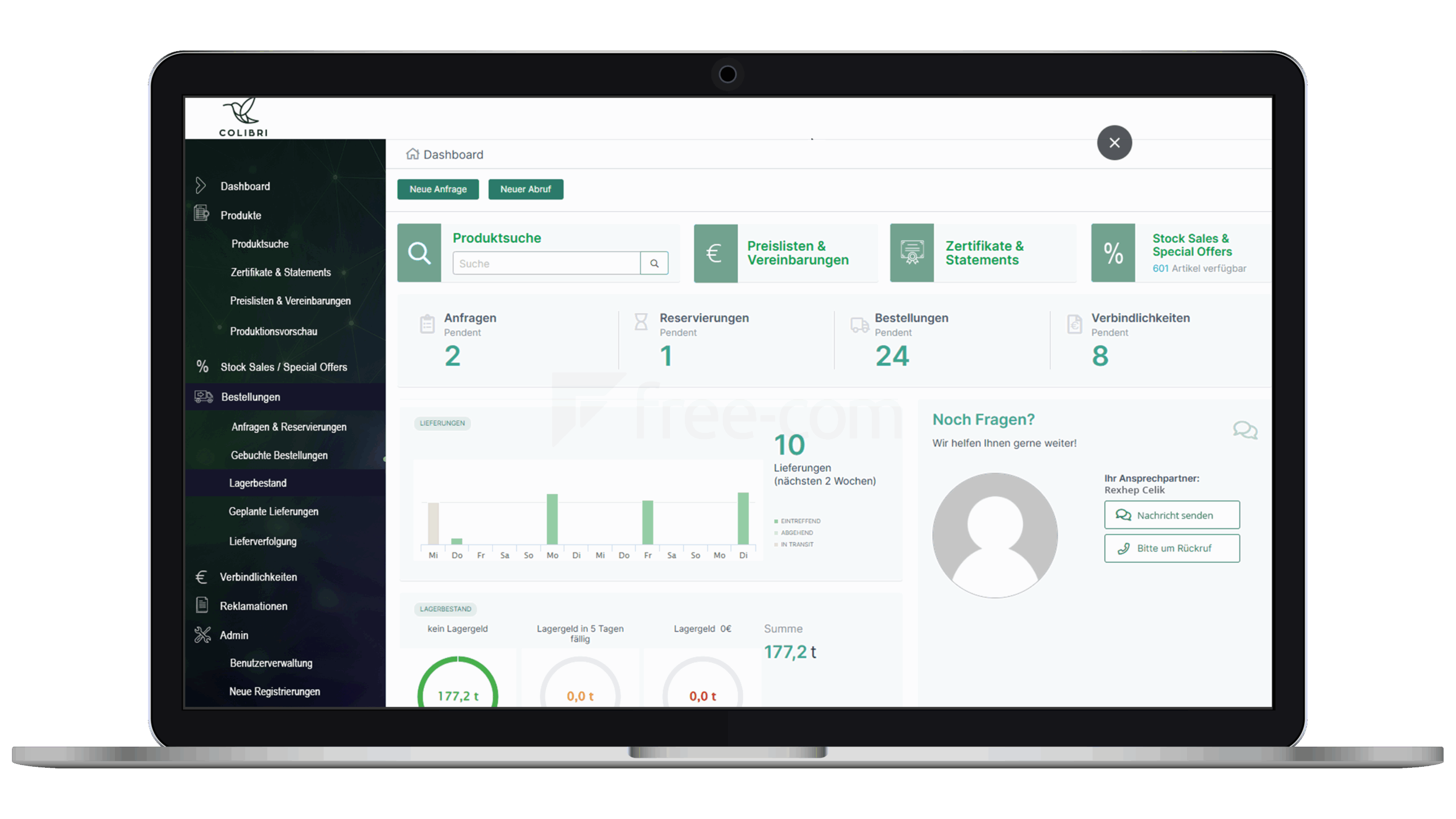Aftersales
Inhalt
- The Importance of Aftersales as a Business Area
- Typical Aftersales Processes
- High (Potential) Share of Aftersales in Total Revenue
- Customer Expectations in Aftersales
- Traditional vs. Digital Aftersales
- What is an Aftersales Portal?
- Smart B2B Portal with AI Assistance
- Functions of a Digital Aftersales Portal
- Advantages of Digital Aftersales Processes
- Conclusion
Inhalt
- The Importance of Aftersales as a Business Area
- Typical Aftersales Processes
- High (Potential) Share of Aftersales in Total Revenue
- Customer Expectations in Aftersales
- Traditional vs. Digital Aftersales
- What is an Aftersales Portal?
- Smart B2B Portal with AI Assistance
- Functions of a Digital Aftersales Portal
- Advantages of Digital Aftersales Processes
- Conclusion
Definition Aftersales:
Aftersales (or after-sales service) refers to all activities and services provided by a company after the sale of a product or service. Its goal is to support customers and build long-term customer loyalty.
Typical processes include handling all kinds of service requests: from technical support for user questions to resolving problems or complaints. Targeted measures following the purchase (e.g., maintenance offers or training courses) are designed to reinforce customers’ purchasing decisions and encourage them to make follow-up purchases. Marketing measures such as upselling and cross-selling, i.e., offering complementary products or services, also fall within the scope of aftersales.
The Importance of Aftersales as a Business Area
Historically, aftersales did not play a major role for a long time. Many companies viewed aftersales service as a necessary evil or a chore to deal with customer problems without making any money from it. Aftersales was often seen as an appendage to sales that tied up resources but received little strategic attention. However, this understanding has changed fundamentally.
With the saturation of many markets and increasingly interchangeable products, companies began to rethink their approach. Acquiring new customers became expensive and laborious, while at the same time competitive pressure increased. In this situation, it was recognized that outstanding aftersales service can be a real competitive advantage: when technical differences between products become increasingly small, service quality often determines which product is chosen. A provider that offers exemplary support to its customers after the purchase can stand out from the crowd and retain customers in the long term.
As a result, companies increasingly bundled service activities, professionalized processes, and developed dedicated service teams. The result is that aftersales is now managed as a profit center in many places. Accordingly, considerable investments are now being made in the expansion of service organizations, digital aftersales platforms, and new service offerings. Aftersales has also become a pillar of differentiation: companies are using service innovations (such as predictive maintenance or availability-as-a-service concepts) to set themselves apart from the competition and create added value for their customers.
The core idea behind aftersales is that a sale is not a one-time event, but part of a long-term business relationship. And it is not the product alone, but the entire support cycle that determines the success of the company.
Typical Aftersales Processes
Operationally, the aftersales area encompasses numerous services. These range from the supply of spare parts and the performance of maintenance to the processing of complaints and training in the correct use of the product. Support hotlines, regular service checks, and the administration of service contracts are also included. Specifically, the following tasks and services are part of aftersales:
The tasks in aftersales vary depending on the industry and product. An aftersales manager typically handles customer service, warranty claims, complaints, training, and similar services. All of this is done with the aim of ensuring smooth product operation and high customer satisfaction.
High (Potential) Share of Aftersales in Total Revenue
Aftersales is particularly comprehensive in the B2B environment. Business relationships in the key account business often last for many years, and expensive capital goods must be supported throughout their life cycle. Accordingly, in B2B, it is not only product quality and price that determine success, but also, and above all, the service offered after the purchase. Studies (including BCG, 2025; McKinsey 2023) impressively confirm this: for manufacturers of machinery and equipment, aftersales services can now account for 30–50% of total sales, often with significantly higher margins than the initial sale. Services such as maintenance or spare parts sales achieve gross margins that are often twice as high as in the new machine business. In some cases, aftermarket services even generate many times the margin of new business. Aftersales is therefore a tangible strategic business area.
Why is this the case? On the one hand, because existing customers remain loyal when they receive good service and make regular repeat purchases (recurring revenue). On the other hand, because satisfied customers are more willing to book additional services, be it a maintenance contract, an upgrade, or training for employees. Good aftersales service significantly extends the lifespan of the customer relationship. In addition, it increases the willingness to recommend the company to others, which can lead to new business. Companies that invest in this area strengthen customer trust and loyalty, thereby securing competitive advantages.
Customer Expectations in Aftersales
Customer expectations in aftersales For your customers, fast and reliable aftersales support is a given these days. They expect not to be left alone once the purchase contract has been signed. In practice, this means that fast response times and competent help with questions or problems are essential. If, for example, a machine part fails, B2B customers rely on rapid support – ideally immediately via hotline or remote diagnosis and with readily available spare parts delivery to keep downtime to a minimum. As a general rule, any difficulties that arise should be resolved in a straightforward and comprehensive manner in the customer’s best interests.
Typical expectations in aftersales also include transparency (such as clear information on warranty conditions, repair times, or costs), reliability (adherence to commitments, e.g., response times from service contracts), and goodwill wherever reasonable. Customers want to feel that they remain “special” to your company even after the purchase. This includes, for example, proactively reaching out to them – whether with maintenance reminders, software updates, or offers to optimize the use of the product. A positive aftersales experience strengthens the relationship: if your customers feel well looked after and taken seriously, they are more likely to remain loyal and even recommend your company to others. Conversely, bad experiences after the purchase can damage your reputation. All in all, decision-makers on the customer side expect aftersales service on an equal footing – quick solutions, contact persons who understand their needs, and the good feeling of being with the right company.
Traditional vs. Digital Aftersales
In traditional, personal aftersales, customer concerns are usually submitted via email, telephone, or support chat. The processes are manual and fragmented: customers contact the company because they need a replacement part, sales staff create a quote in the ERP system, and customers send a written order. It takes days for the process to be completed. In the worst case, the customer’s machine is idle during this time. Or there is a technical question and there is no central service portal on the website, only an overloaded telephone hotline that is stressful for everyone involved. These analog processes take time, are prone to errors, and no longer meet today’s expectations.
Today’s B2B customers expect immediate information, a continuously available point of contact, and uncomplicated processes. Studies show that the majority of B2B decision-makers clearly prefer remote interactions or digital self-service to the traditional sales channel. Only 20-30% of B2B buyers still want personal contact with customer service representatives (McKinsey, 2020).
Companies are being forced to rethink their approach: central service portals are taking center stage.
What is an Aftersales Portal?
An aftersales portal—often referred to as a service portal, B2B customer portal, or self-service portal—bundles all relevant data and functions in one central location. Users log in online and can independently handle issues that previously required manual support.

Digitized aftersales processes mean transparency, centralized information, and fast processing of inquiries. For customers, this eliminates the frustration of waiting or searching for the information they need. Internally, tedious routine work is eliminated and the focus can be placed on other tasks.

Smart B2B Portal with AI Assistance
We combine self-service and aftersales services in a platform that intuitively solves even complex business requirements. Users can place orders, check status, or create support tickets around the clock.
An integrated AI (chatbot) takes care of routine tasks and automatically answers many questions in real time. The result: maximum efficiency and a seamless digital process for everyone involved.
Functions of a Digital Aftersales Portal
An outstanding aftersales portal is characterized by certain key functions that cover the entire service process. Here are some of the most important features that decision-makers should be aware of:
This list is only an excerpt of possible and helpful functions. The portal thus becomes a hub for all downstream processes. It is important that the user interface is clear and easy to use so that users enjoy working with it and can find their way around.
Advantages of Digital Aftersales Processes
24/7 Service
A self-service portal is available at all times, even on holidays. This increases satisfaction because problems are solved more quickly and customers feel well taken care of.
Greater Efficiency
Standard inquiries are transferred away from your team. This reduces the workload on your employees, lowers process costs, and makes after-sales scalable without having to increase staffing levels accordingly.
Reduction of Errors & Time
Automated processes reduce misunderstandings and errors that can arise when data is entered manually. Processing times are reduced from days to minutes.
More Revenue
Online sales allow you to tap into potential that might otherwise remain untapped and reach new customer groups. Personalized recommendations on the portal also actively promote additional sales.
Data Creates Added Value
The portal automatically collects valuable user data that is particularly helpful in business development. In the medium and long term, this enables you to improve your offering, develop new business areas, and even create new business models.
Customer Loyalty
Fast service and a personal approach strengthen loyalty and reduce customers’ motivation to look elsewhere. You are seen as a reliable partner and remain the preferred choice on the market.
Conclusion
Aftersales in the digital B2B era is much more than just “customer service.” It is an essential part of value creation and the key to loyalty and additional business. Modern B2B customer portals transform what used to be a tedious aftersales service into a fast, efficient, and often even inspiring experience—for customers and your own team. Decision-makers should therefore take a strategic approach to aftersales: every dollar invested can pay off in multiple ways—in sales, customer satisfaction, and competitive advantages.
Do you have any questions for us?
We would be happy to advise you during a short, non-binding online appointment!











